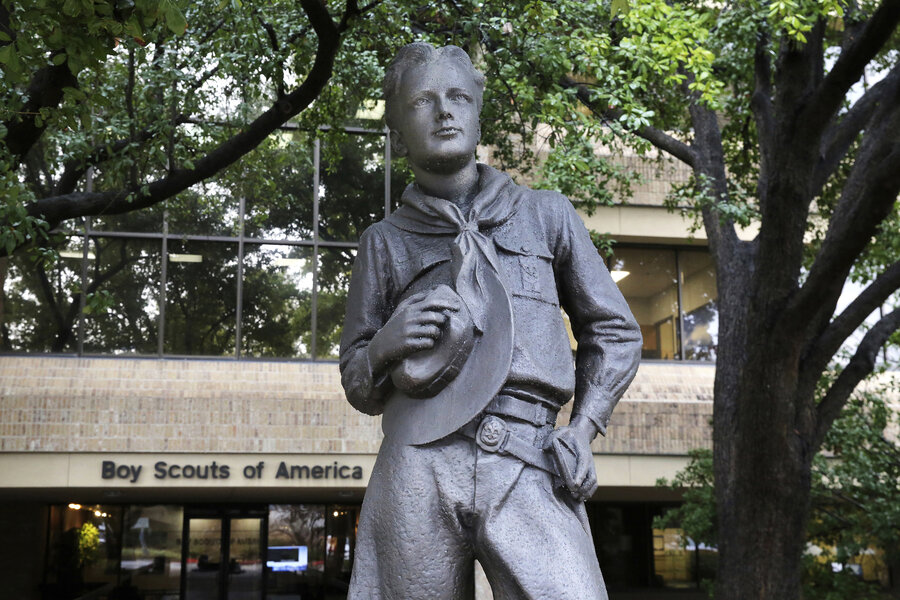Boy Scout settlement could be largest in U.S. sex abuse cases
Loading...
| Dover, Delaware
The Boy Scouts of America (BSA) have reached an $850 million agreement with attorneys representing some 60,000 victims of child sex abuse in what could prove to be a pivotal moment in the organization’s bankruptcy case.
The agreement filed in court by BSA attorneys late Thursday would mark one of the largest sums in U.S. history involving cases of sexual abuse. The filing, known as a restructuring support agreement, includes the BSA, abuse victims, local Boy Scouts councils, and lawyers appointed to represent victims who might file future claims.
“After months of intensive negotiations, the debtors have reached resolution with every single official and major creditor constituency in these Chapter 11 cases,” BSA attorneys wrote.
The Boy Scouts of America, based in Irving, Texas, sought bankruptcy protection in February 2020, moving to halt hundreds of lawsuits and create a compensation fund for men who were molested as youngsters decades ago by scoutmasters or other leaders.
But BSA attorneys have been unable to get attorneys for victims, the BSA’s local councils and sponsoring organizations, and insurers to agree on a global resolution that would compensate abuse victims while allowing the 111-year-old organization to continue operating.
The agreement signals the BSA’s acknowledgment that the gulf between attorneys representing abuse victims and those representing the BSA’s insurers is currently too broad to be resolved. They may very well be left to resolve their differences in future court battles, a prospect that the BSA had sought to avoid.
In an earlier court filing Thursday, attorneys for certain insurance companies accused the BSA of allowing attorneys for abuse victims to rewrite the BSA’s restructuring plan to include terms favorable to their clients.
“With only the fox guarding the henhouse, the outcome is utterly at odds with what BSA itself asserted was necessary for a confirmable plan and is permissible under the bankruptcy code,” the insurers wrote.
Attorneys for insurers appear to be particularly concerned that the BSA’s liability for abuse claims would be adjudicated under proposed trust distribution procedures in an effort to decide insurance coverage issues.
Meanwhile, in connection with the restructuring support agreement, attorneys for the Boy Scouts are asking for U.S. Bankruptcy Judge Laurie Selber Silverstein to declare that they have no obligation to seek court approval of a previously announced settlement with The Hartford, one of the BSA’s insurers.
The Hartford agreed to pay $650 million into the victims’ trust in exchange for being released from any further obligations under policies dating to 1971. The agreement allowed The Hartford to pay a lesser amount if the BSA or the settlement trust reaches an agreement with another major BSA insurer, Century Insurance Group, and Century’s settlement amount is less than two times The Hartford’s, or $1.3 billion.
The Hartford settlement was roundly criticized by attorneys for abuse victims, who estimate the insurer’s liability exposure at several billion dollars. They made it clear that victims would not support any plan that includes The Hartford settlement.
The Boy Scouts have said that between $2.4 billion and $7.1 billion, including insurance rights, might be available for abuse victims. Attorneys for the tort claimants committee, which is charged with acting as a fiduciary in the bankruptcy case for all abuse victims, have estimated the value of some 82,500 sexual abuse claims at about $103 billion.
“All plaintiff representatives, who represent the vast majority of the holders of direct abuse claims, have indicated that any plan containing the Hartford Settlement would be categorically rejected,” BSA attorneys wrote in Thursday’s court filing. “Without their support, to be forced to pursue a plan that incorporates the Hartford settlement appears futile.”
Matthew Sturdevant, a spokesperson for The Hartford, said the company’s agreement with the Boy Scouts “is a crucial building block to move this bankruptcy case toward a conclusion.”
“We are disappointed that the Boy Scouts of America have chosen to flout the organization’s tenet of keeping promises by seeking to discard a thoughtfully negotiated and mutually agreed-upon deal that appropriately values The Hartford’s obligations,” Mr. Sturdevant said.
In a joint statement, representatives for the victims as well as future claimants representatives said the restructuring support agreement will allow the Boy Scouts to emerge from bankruptcy “while providing meaningful compensation to the victims, and holding the Boy Scouts’ insurers to the terms of the insurance policies purchased by the Boy Scouts and their affiliates over many decades.”
In a revised plan submitted barely two weeks ago, the BSA offered to issue an $80 million unsecured promissory note to a trust fund for abuse victims. It also proposed using restricted assets to help cover post-bankruptcy operational expenses, which would make up to $50 million in unrestricted cash available for abuse survivors. With the changes, the BSA’s proposed contribution to the trust fund would increase from about $120 million under a previous plan to as much as roughly $250 million.
Under a new plan expected to be filed Friday, the BSA’s 250-odd local councils would contribute $600 million into the fund for abuse victims, double an offer of $300 million from earlier this year.
In return for their contributions to the trust fund and the transfer of insurance rights, the BSA and local councils would be released from liability. Sponsoring organizations such as churches and civic groups also could be released from further liability in exchange for contributing to the fund and transferring insurance rights.
A hearing in the case is scheduled for July 20.
This story was reported by The Associated Press.







